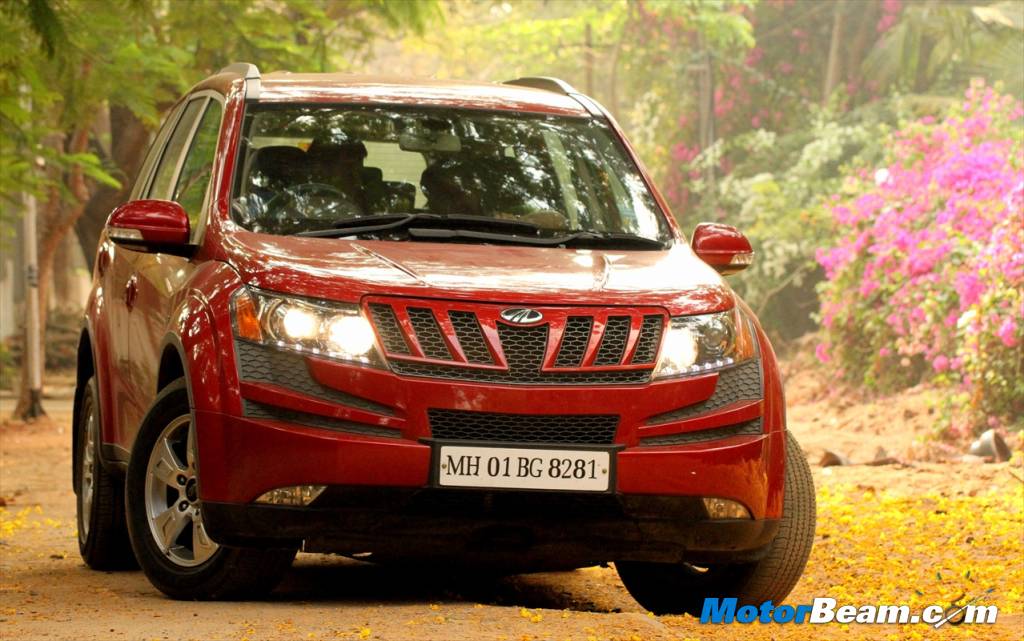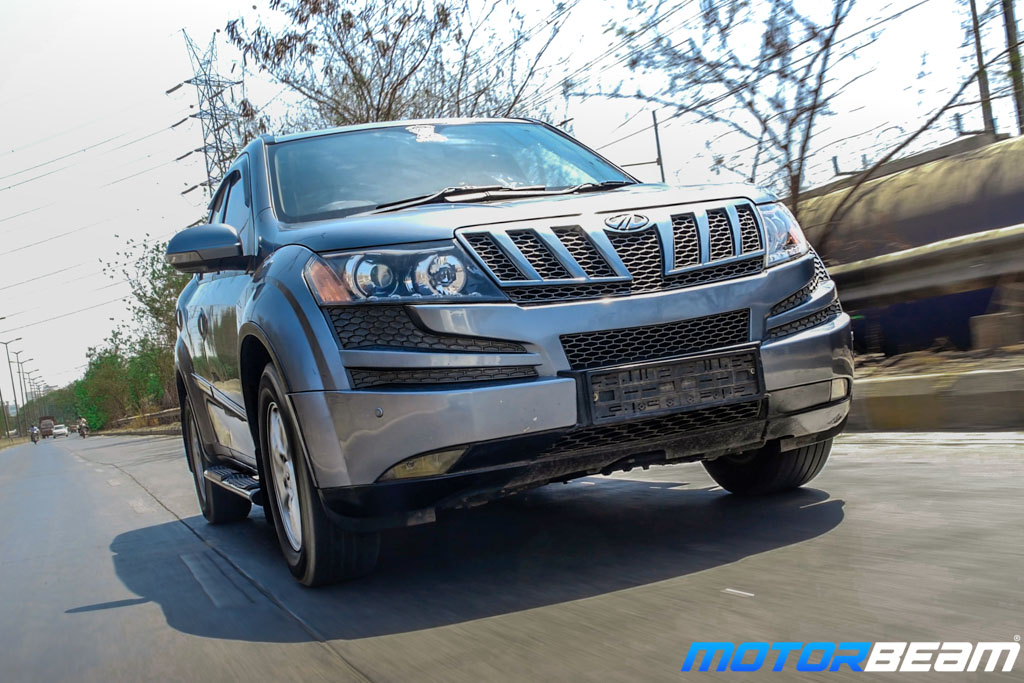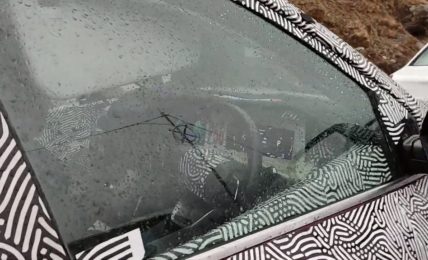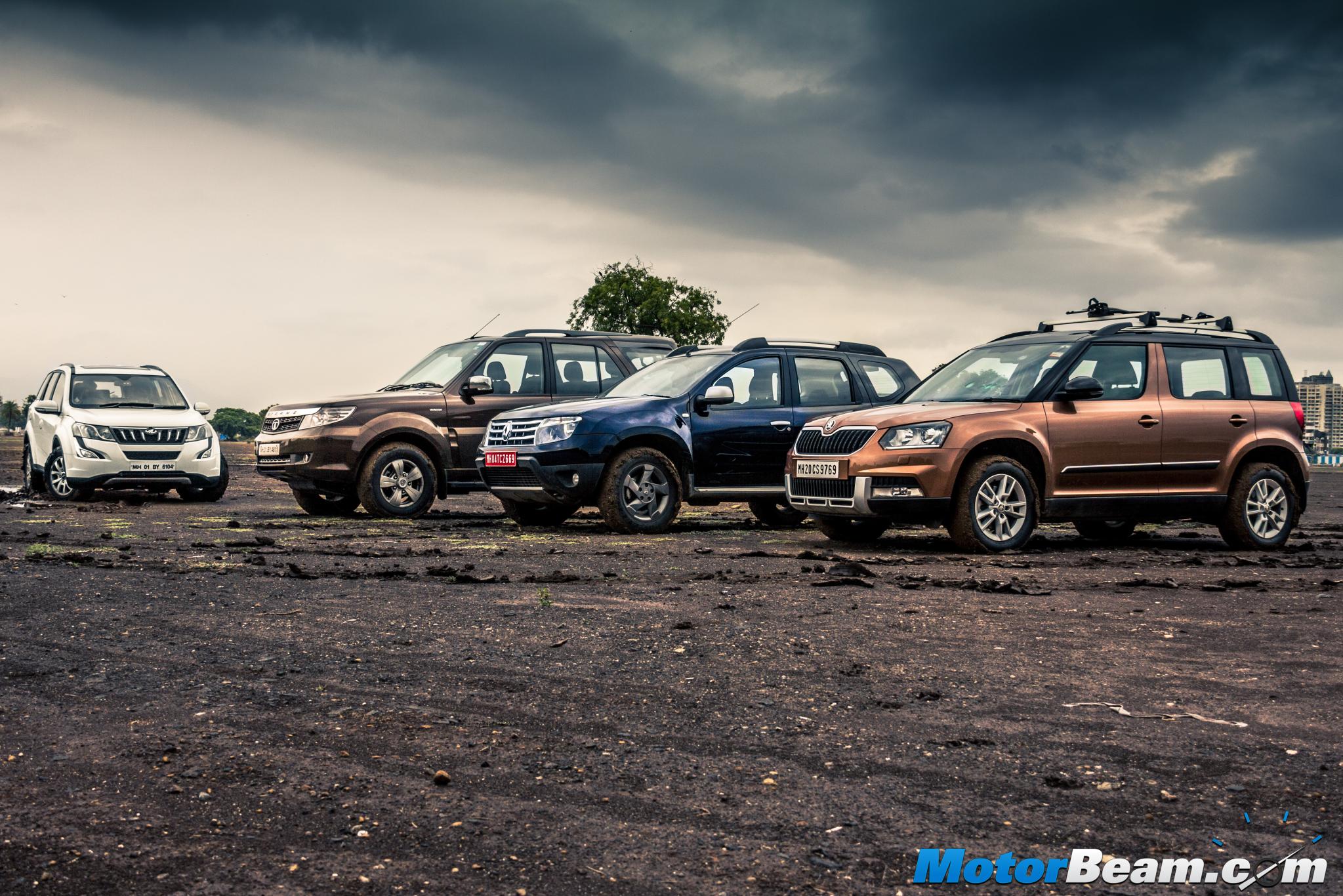
Shootout: Renault Duster vs Tata Safari Storme vs Mahindra XUV500 vs Skoda Yeti
Price OTR Mumbai: Rs. 13.95 – 15.91 lakhs (Renault Duster 110), Rs. 12.17 – 17.07 lakhs (Tata Safari Storme), Rs. 13.63 – 19.38 lakhs (Mahindra XUV500), Rs. 24.20 – 26.23 lakhs (Skoda Yeti)
Being SUVs, all do have off-road capability while they also perform very well on the road
We at MotorBeam love to do shootouts. In fact whenever we get to drive a car or bike, we think about doing a comparison too. So when the updated Tata Safari Storme was launched, the immediate thought was to put it against the Mahindra Scorpio, its immediate rival. But since we had done the same with the pre-facelift Safari not so long ago (link to the review in the further reading section) and since Tata Motors has made little changes to the new model, the result wouldn’t change making it not exciting for us. But then Mahindra launched the ‘New Age XUV’. So naturally two facelifted models going head-on against each other seemed like a good idea. But since the XUV has no competition, we decided to bring in the Skoda Yeti which too doesn’t have any direct competition. This meant the Safari was contesting with two cars which aren’t its direct rivals so in came the Renault Duster too. We ended up with four SUVs which are as different as chalk, cheese, buttermilk and pasta. This isn’t your normal comparison as my colleagues had a lot to say about all these cars.
Motor Quest: The Skoda Yeti is the oldest car here, being launched in 2010 with the facelift going on sale in September 2014. The Mahindra XUV500 was launched in 2011 and just like the Safari, its facelift too came earlier this year. The Storme and Duster were both launched in 2012 with Renault adding the AWD version last year.
A storm is brewing above these four awesome SUVs, the Safari having the most presence
Styling – Four cars and the three of us evaluating them. Javeid was quick to write off the Tata Safari calling it outdated and devoid of any significant change in spite of Mahindra going upside down with the Scorpio. Meanwhile, Parth was quick to mention that the Safari Storme’s dimensions are too huge and he is happy scaring off the rickshaws. Me being a big Safari fan, came to look at the car with a microscope, being irritated at the fact that a facelift carries the same alloy wheels, side profile, rear and what not. All of our eyes turned towards the Mahindra XUV500, the new design elements sure look nice and Mahindra knows its design very well but still none of us found the presence of the massive Safari in the Cheetah.
Leaving their mark firmly in place, these vehicles don’t shy away from going off tarmac
The Duster & Yeti can’t match the Indians in size
Moving onto the smaller cars and starting with the cheaper model, the Renault Duster seems quite dated a design, more so because all of us who consider ourselves tech savvy, have been browsing through the company’s international website only to realise that the French automaker has chosen not to give us the sharper looking facelift in India. Although Renault did update the Duster with the AWD version and later the regular variants too, it still doesn’t look fresh in front of the other cars. Renault did call the mildly updated Duster as new gen and so does Mahindra call the XUV the new age. On that aspect, Parth got a clean shave and called himself a new gen journalist, maybe words like these mean little. The Skoda Yeti was updated only last year and its small size is probably the only other chink in its splendid armour. In fact, in front of the XUV500 and Safari, the Yeti and Duster look like dwarfs. Actually, even the Mahindra vehicle looks small in front of the ‘Beast’, aka the Storme.
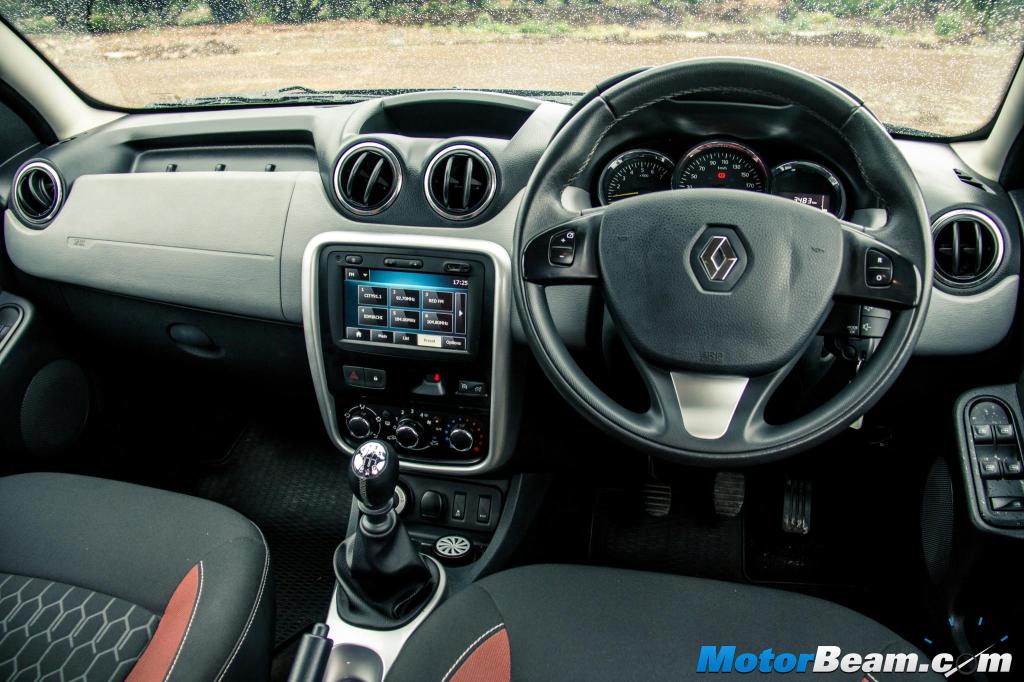
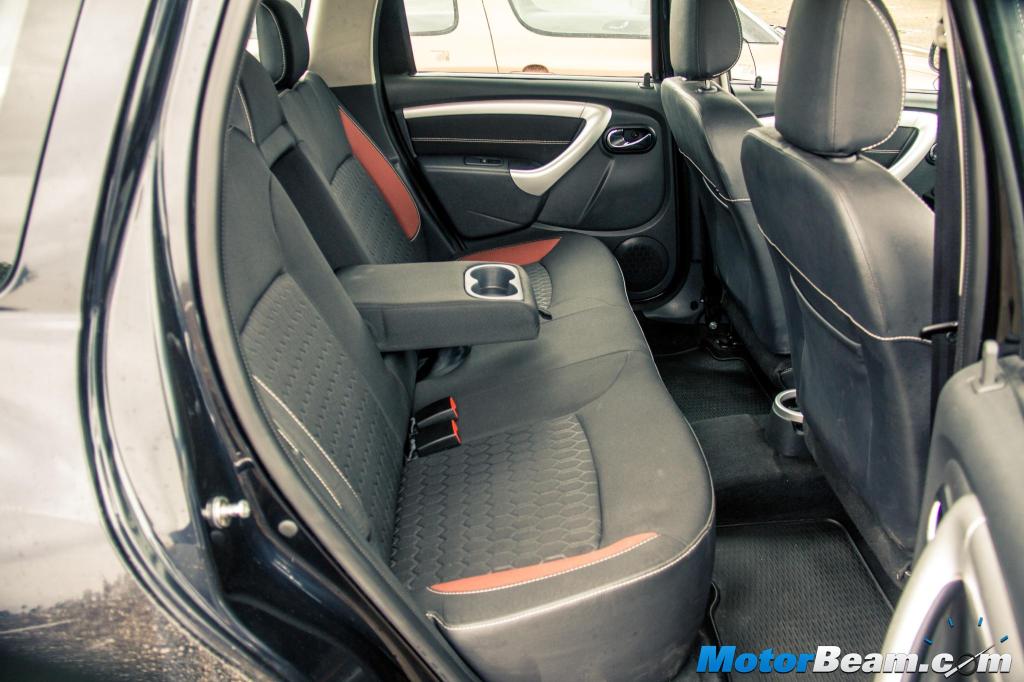
The Duster’s interiors lack the finesse you expect from a car of this price, it does feel low rent in here
Interiors – Starting with the cheapest vehicle here, all three of us get inside the Renault Duster first. The dashboard, quality, fit, finish and design don’t feel upto the mark for a car of this price. In fact, blindfold someone and ask them about the cost of this vehicle, no one will dare say anything above Rs. 10 lakhs while our test car costs a whooping Rs. 16.74 lakhs! You get the standard features expected at this price but no climate control like the Safari Storme but there is a touch-screen audio system with navigation, it does miss out on rear AC vents though (surprising as the old Duster had it). Space inside is decent, far from being the best in this crop of SUVs. The Duster and Yeti are 5-seater cars and thus they naturally have a big boot without one having to be in the dilemma of carrying more people or luggage. But between the Duster and Yeti, it’s the Renault which has the bigger boot while the Safari trumps the XUV in terms of trunk capacity.
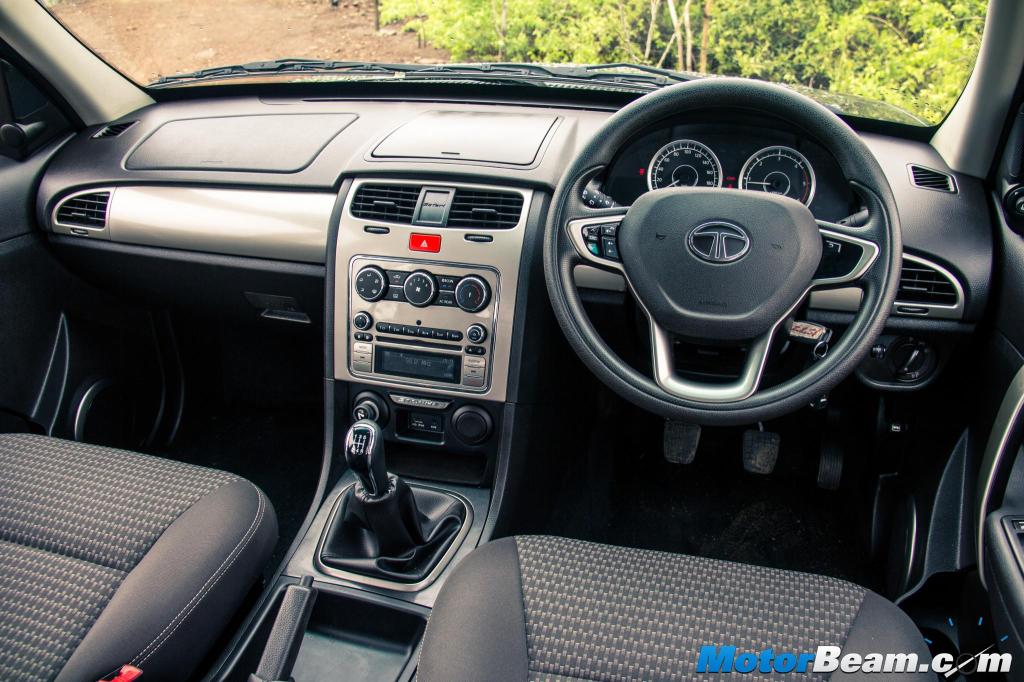
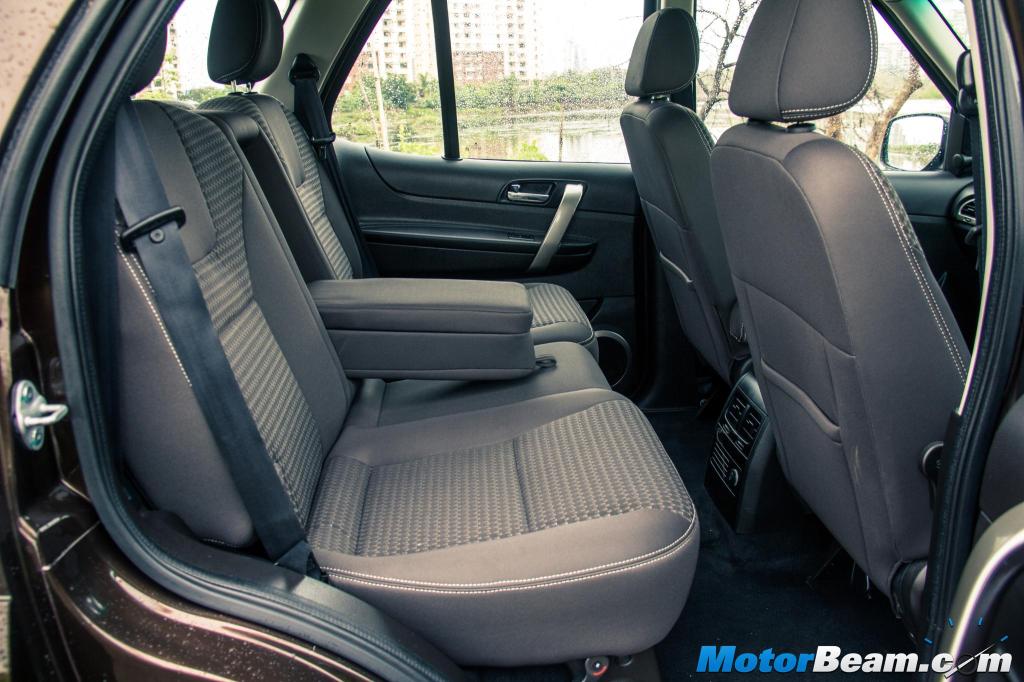
The Safari Storme might lack in equipment but what a terrifically spacious vehicle it is with the massive cabin
The XUV500 & Yeti are loaded with features, the Mahindra more so
Next up, we get into the Safari Storme and Parth quickly points out that the company has Instagrammed the car. Because the interior remains largely the same save for the beige being replaced by black (like an Instagram filter), the new steering and new centre console. A little changes here and there but nothing substantial to talk about. The Safari is the most poorly equipped car of this lot, missing out on so many things that you will have to pinch yourself to realise it is 2015. Just one look at the instrument cluster and you are in disbelief, more so after having driven the Bolt and Zest which are far better equipped for half the price. But before we could continue on our rant about the Safari’s lack of equipment, our assistant editor calls up from Delhi and uninvitingly becomes part of the assessment. “The Safari is not a car, it’s a masterpiece, just look at that commanding driving position, spacious interiors, most storage space, bla bla..” he quips. We turn off our phones and get into the rear seat, only to agree with Aariz about how spacious and comfortable the Safari is. Even the quality has improved drastically and while the Yeti feels by far the best put-together, the Safari and XUV aren’t far apart from each other with the Duster being around the same ballpark as the Indian SUVs.
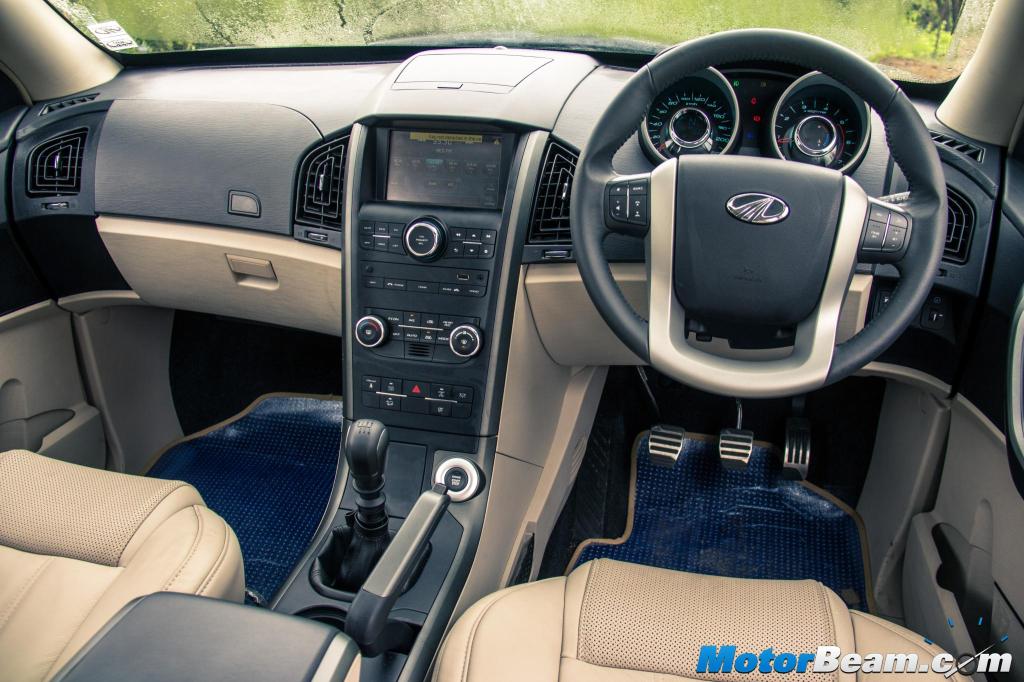
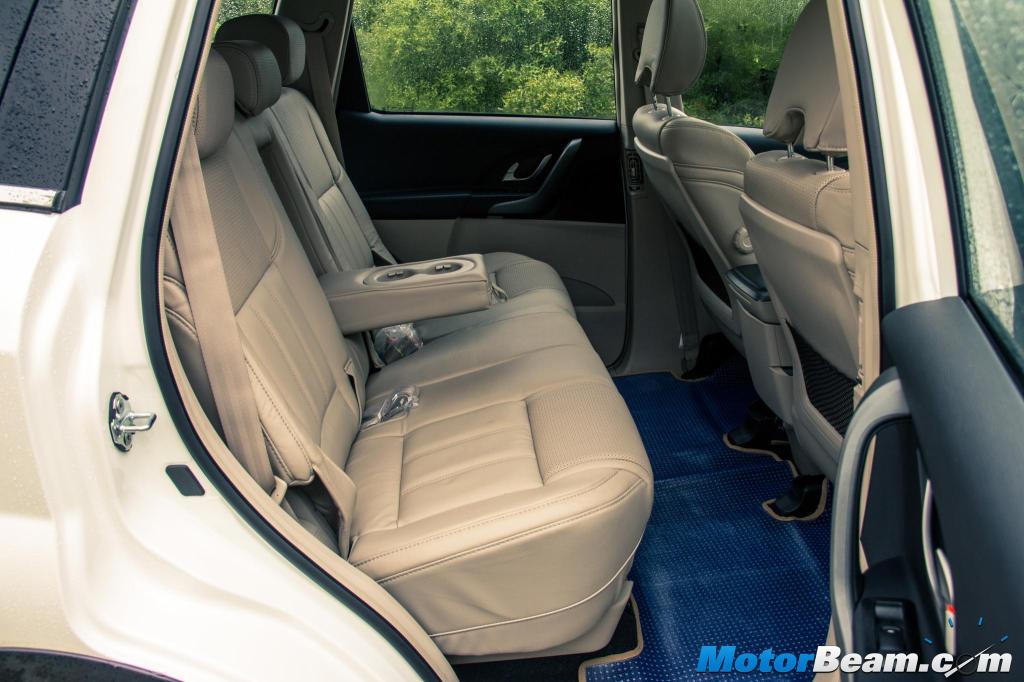
Not the best in quality but Mahindra has done a fine job by loading the XUV500 with a ton of features
The Mahindra XUV500 is the most loaded car of these four SUVs. There are so many features in this car, it’s truly astonishing. You name it, the XUV has it, right from a sunroof to vehicle app, voice commands, static bending lights, keyless GO and the list is endless. Heck, it also projects XUV500 on the road at night from under its rearview mirrors. It’s only the Skoda Yeti which can come close to the Mahindra in terms of equipment (it too gets tyre pressure monitoring, button start, electric adjustment for the driver’s seat, cruise control, etc.) and for the price, it better be well equipped but misses out on a rear parking camera. The XUV’s last row is almost useless but so is the Safari’s with its claustrophobia inducing side facing jump seats. If you want to seat 7 in comfort, you are better off in a Toyota Innova.
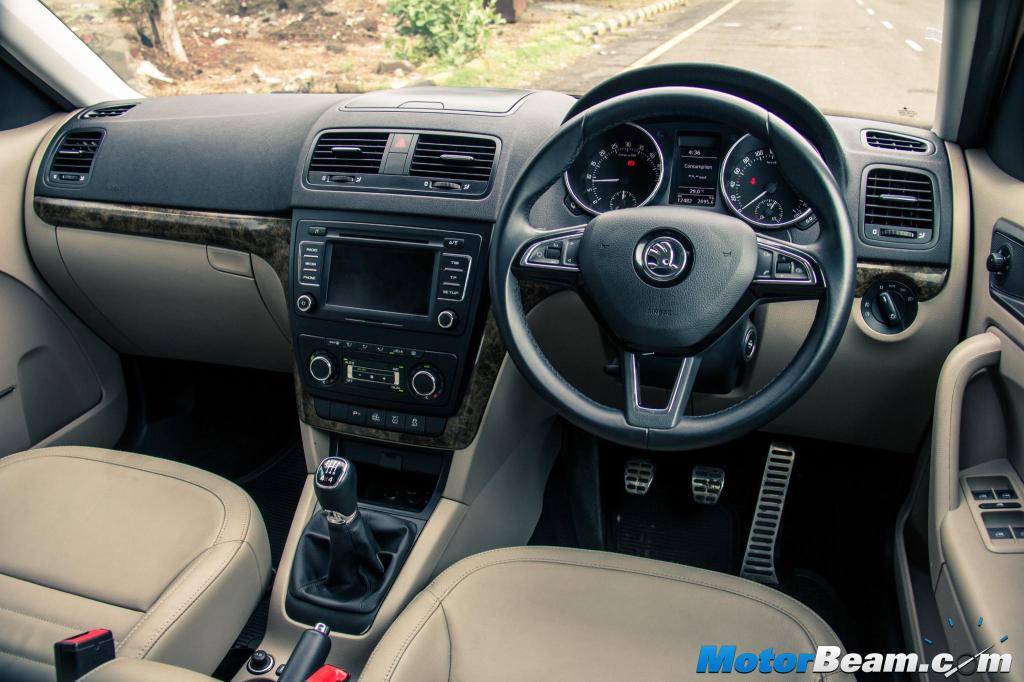
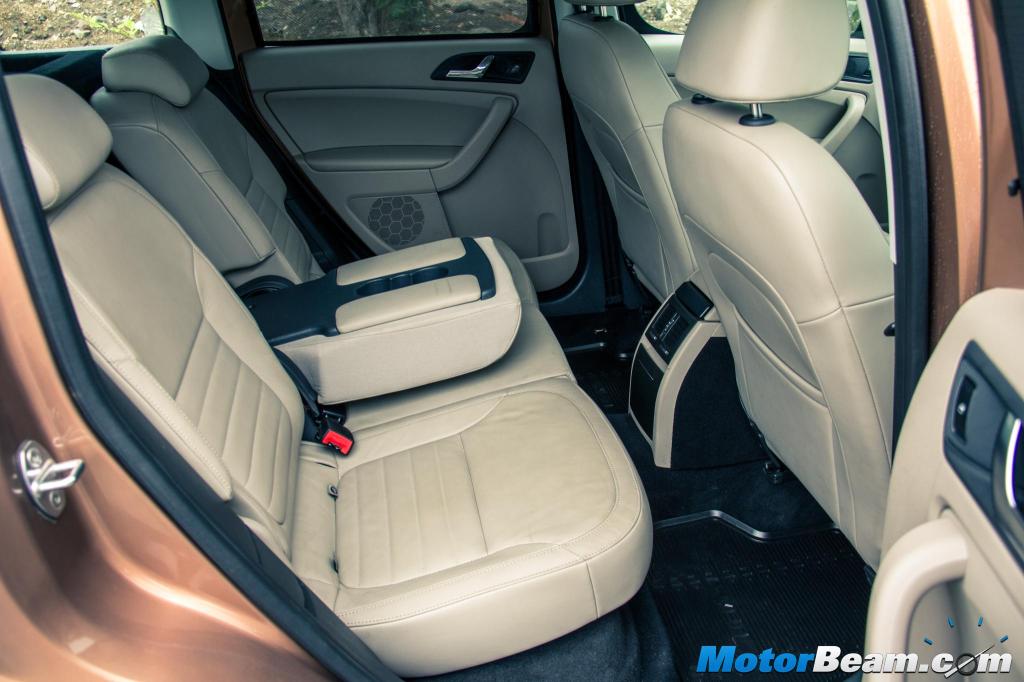
Skoda’s quality is by far the best but you expect that from a European car, more so since it’s the most expensive here
Last but not the least, the Skoda Yeti which feels the least SUV here due to its dimensions. You sit the lowest in the Yeti, feeling the least bit macho but the interior is the most sophisticated with the typical Skoda dashboard, top notch German build quality and excellent seats (can fold them independently to boost carrying capacity). While all other cars can seat 5 (or 7 in case of the XUV and Safari), the Yeti can at best seat four due to the protruding rear AC vents. All three of us agree that the Skoda Yeti’s interior is the best while the Mahindra is the most loaded and the Safari is the highest on space. Meanwhile the Duster doesn’t have anything special to offer but it’s also the cheapest car here when you consider there is a lower 85 PS diesel engine on offer.
The Yeti is clearly the fastest car of the bunch and makes the others look quite slow
Performance – All these four cars come powered by a diesel engine. The Safari Storme and XUV500 use a similar 2.2-litre motor which Tata badges as VARICOR while Mahindra uses the mHawk moniker to best describe it. The Safari is the most powerful SUV here, producing 150 PS and 320 Nm while the XUV500 generates 140 PS and a higher 330 Nm of torque. Meanwhile the Yeti draws power from a 2.0-litre mill which outputs 110 PS/250 Nm in 4×2 guise and 140 PS/320 Nm in 4×4 avatar. The Duster is the least powerful here with its 1.5-litre dCi mill belting out 110 PS and 245 Nm. Except the Safari and the Yeti 4×2, all cars are matched to a 6-speed manual gearbox and it is the Yeti which has the best transmission of this lot, followed by the Renault, the home grown automakers offering a notchy feel on the lever.
The XUV500’s lower weight makes it marginally faster than the powerful Safari
The Duster has a small engine but in spite of that, it’s quick while the Indian SUVs use a similar motor
While on paper, the Safari seems the fastest, things change drastically on the road. Before plugging in our VBOX, we did some fun runs with the cars and since the Duster and Yeti are much lighter, we were quite sure about them being quicker than the Tata and Mahindra vehicles. But between the Safari and XUV500, which one is faster? A quick drag race showed the Storme leading by a hair’s length and mind you, our test XUV500 is a AWD model while the test Safari is a 4×2 version. The 4×4 Safari is by far the slowest of this pack while even the 4×2 Safari, in spite of being the most powerful, comes out last in the 0-100 km/hr sprint, taking 14.11 seconds. Meanwhile the XUV500 AWD did the run in 13.57 seconds with the 2WD trim being even faster thanks to its lower weight.
What’s common between these cars? They all use a monocoque platform unlike the Safari
Among the smaller 5-seater SUVs, the Renault Duster AWD managed to do the 0-100 km/hr sprint in 12.54 seconds while the Skoda Yeti proved its mettle by posting a time of 9.91 seconds. After driving the XUV500 and Safari and then getting into the Yeti, one feels the Skoda is a rocket, it’s so quick and responsive due to its lower weight that you instantly feel like you are flying. This is because the Duster AWD weighs 1300 kgs, the Yeti 4×4 tips the scales at 1543 kgs while the desi SUVs weigh 1740 kgs for the XUV500 and 1965 kgs for the Safari Storme, the Tata vehicle does need to go on a diet but to its credit is the chassis as it’s the only one using a body-on-frame construction here. The Duster also feels very quick in comparison to the 7-seater SUVs, the Renault and Skoda having a much higher top speed too. But in spite of being the slowest here, the Safari is no slouch, it has more than enough punch for both city and highway duties and responds very well to throttle inputs, just like the XUV500.
The XUV500 has more power and torque but the Duster is quicker and more frugal
The Renault Duster has the best low-end performance, it also has the lightest clutch of the lot and things were quite the different till the French automaker made amends on the AWD version. All cars have a strong mid-range, the Yeti having the strongest of them all with a shove that can leave you stuck to your seat. NVH levels are better on the Duster while the Yeti follows second (both cars are more at home when nearing their redline) but you will certainly realise it is diesel that is powering these SUVs. With the smallest engine in the pack, the Duster manages to be the most frugal at 14 km/l, followed by the Yeti at 12.5 km/l while the XUV500 manages 11.5 km/l and the heavy Safari comes last at 10 km/l. The Mahindra has the biggest fuel tank of 70-litres while the Safari has a 63-litre tank, the Yeti 4×4 has a 60-litre tank (55-litres on the Yeti 4×2) and the Duster has a smaller 50-litre tank.
The Safari isn’t about 0-100 km/hr times, it’s about the feel which is just something else
The Yeti is quick, the Duster is frugal while the Safari & XUV are torquey
While driving these cars, all of us loved the Skoda Yeti for its performance, Renault Duster for its low turbo lag and the desi SUVs for the torquey character of their engines. But before we could conclude, Aariz somehow managed to convey a message to us, “remember, you are driving an SUV, not a sportscar”. So while the Yeti and Duster are quick, it’s actually the Safari and XUV which have a feel of an SUV from their relatively less impressive NVH. My colleagues won’t agree and invited me to a drag, Parth taking the Duster and Javeid the Yeti while I took the Safari. As the 1, 2, 3, GO words were said, I took a sharp left, getting off the road onto slushy muddy terrain, to hell with 0-100s!
All cars come with the option of AWD but the Safari is the most potent here
Off-Roading – I might not have won the race but I did win the battle, I thought to myself. All the cars here channel power to all four wheels with our test Safari being 2WD and the only one in the pack which in 2-wheel drive mode is a rear-wheel machine. The XUV500 is the least impressive off-road as power goes to the front-wheel at most times, similar is the case with the Duster but weight is on its side. The Yeti’s 4×4 system is the most advanced and it has an Haldex clutch, Off-Road mode (limits engine RPM by altering ASR and electronic differential lock), hill hold control, downhill assistant and off-road ABS. The company also offers a rough road package where the underbody is sealed to prevent damage on broken terrain. Still, the Safari with its higher ground clearance (200 mm) than the Yeti (180 mm), limited slip differential and traditional underpinnings is the most capable vehicle here.
The Safari Storme leads when it comes to ride quality but lags in handling
Driving Dynamics – One can’t deny the laws of physics and in the case of the monocoque cars (Duster, XUV and Yeti), the lower weight does work wonders in making them car like to drive. The Yeti drives like a car and the Duster is close to the same experience while the XUV500 has some body roll but doesn’t feel heavy like the Safari. The Storme feels like a truck, it’s heavy, has quite a lot of body roll and doesn’t like quick directional changes. In fact, the Tata vehicle is so heavy that Parth didn’t like it much to drive, saying it required too much of effort. Me and Aariz were quick to recommend him a dose of testosterone to boost his manliness.
Among the 7-seaters, the XUV500’s handling is much better with less body roll
The Yeti and Duster have much superior handling compared to the desi cars
So while the Yeti has the best handling, followed by the Duster and the XUV, the Safari scores the least in terms of dynamics but none of the other SUVs can match the Storme when it comes to driving feel. Drive a Safari for a few kms and you will simply love the way it offers the authentic SUV feel which is simply addictive. The Safari Storme also has the best ride quality here, followed by the Duster, Yeti and XUV500. Steering feedback is excellent on the Yeti and Duster but the XUV500 and Safari lack on that front. Braking performance is the strongest on the Yeti while the Duster isn’t far behind in this regard, the home grown SUVs have some nose dive when you pull in the anchors.
The Duster and Safari lack safety kit while the other two gets 6 airbags
Safety and After Sales Service – The Skoda Yeti is the safest car here while the Renault Duster is the least safest. Both the Yeti and XUV500 come with side airbags (a total of 6 airbags) while the Safari and Duster have only dual front airbags. The Yeti and XUV500 also get a host of electronics which are missing on the other two cars here. With no Maruti or Hyundai in today’s comparison, choosing one in the sales and service department becomes tough. Skoda scores the worst here while Tata and Mahindra are both known for below average after sales. Renault’s service seems better in comparison to the rest here.
The XUV500 is the practical choice while the Safari appeals to the heart the most
Verdict – While the three of us have had arguments over many things in this shootout, when it came time to conclude, all of us unanimously agreed that the Skoda Yeti is by far the best car here. The only thing wrong with the Yeti is its price and with only one Elegance trim on offer, the Czech vehicle is way too overpriced for its size. Then there is the Renault Duster which is the cheapest car here (the 85 PS version) but gets too pricey when you talk about the top-end AWD model. The Safari Storme lacks equipment, is the heaviest here but has a soul which none of the cars possess. Its price is quite attractive considering it offers more size for the price. But it’s the Mahindra XUV500 which blends the best of everything, it isn’t as rugged as a Safari or as car-like as the Renault and Skoda but plays middle-ground. Most importantly, the Mahindra vehicle offers value in spades, making the XUV500 the universal choice in this segment.
You won’t go wrong buying either of these SUVs as all have something big to offer. It all boils down to the kind of person you are. Among the MotorBeam team itself, Javeid picked the Duster AWD, Parth picked the XUV500 and I chose the Safari Storme. Surprisingly, all of us would love to have the Yeti because there is no denying, it is by far the best car in this shootout.
You can’t go wrong with either car as all have something very big to offer
Testers’ Note:
If budget no bar, the Skoda Yeti is by far the easy pick as it is the best vehicle here
Picture Editing: Sri Manikanta Achanta
Further Reading –
2015 Mahindra XUV500 Review
2015 Tata Safari Storme Review
2015 Skoda Yeti Review
2015 Renault Duster AWD Review
Tata Safari Storme Long Term Review
Renault Duster Long Term Review
Ford EcoSport vs Maruti S-Cross vs Renault Duster
Renault Duster vs Hyundai Creta vs Mahindra XUV500
Tata Safari Storme vs Renault Duster AWD vs Mahindra Scorpio
Tata Safari Storme vs Mahindra XUV500 vs Renault Duster vs Mahindra Scorpio
Renault Duster vs Hyundai Creta vs Mahindra XUV500 – Video


